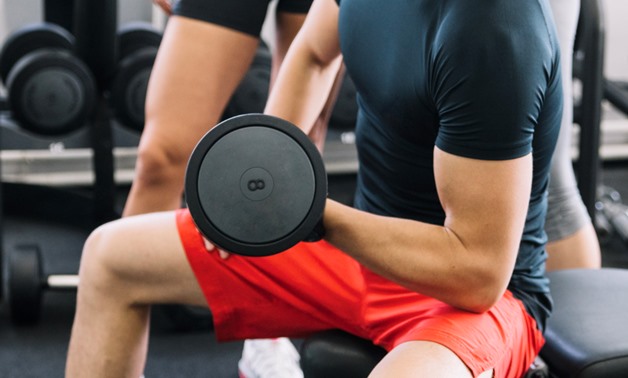
Stock photo
Fitness is one of those topics that nearly everyone has an opinion on, and most are quite vocal about these opinions. For every two fitness truths, however, there’s usually a lie; and sometimes it’s hard to determine which is which. Here are some of the most common myths about working out that could be holding you back from reaching your fitness goals.
Myth #1: Lifting weights will bulk you up.
Truth: It’s actually pretty hard – next to impossible — for women to bulk up from a normal strength-training routine, because they don’t have as much testosterone as men. It’s the difference in this hormone level that makes it easier for men to bulk up. If you’re a woman and weight loss is your goal, strength training can actually help you lean out—but you have to keep your nutrition in check too.
Myth #2: You can focus on losing fat from certain body parts.
Truth: As much as you may like to believe it, spot training is not a thing. Fat cells are distributed across your entire body. If you want to lose fat from a specific spot, you need to lose overall body fat through a sensible nutrition and exercise plan.
Myth #3: Doing lots of cardio is the best way to lose weight.
Truth: If your goal is weight loss, jogging endless miles on the treadmill isn’t always the best approach. Yes, traditional cardio workouts will help create a day-to-day calorie deficit (in addition to a healthy lifestyle), which is essential for losing weight. But in the long term, having more lean muscle mass, which comes from strength training, will help your body burn more calories at rest, so a combination of both high-intensity cardio and strength training is a good idea.
Myth #4: Not feeling sore means you didn’t get a good workout.
Truth: While soreness and workout intensity are sometimes connected, how tired your muscles feel isn’t always a good indicator of a solid sweat session—it just means that a significant amount of stress was applied to the tissue. Proper recovery will help prevent achy muscles. Refuel within the first 30 to 45 minutes post-exercise, stay hydrated, and get enough sleep. All of these things can help boost recovery and minimize soreness.
Myth #5: Strength training means using machines and heavy weights.
Truth: Strength training means using resistance to work your muscles and that resistance doesn’t necessarily have to come from a machine or a heavy weight. Aside from using your own bodyweight, you can also use tools like kettlebells, medicine balls and resistance bands to add resistance.
Myth #6: The more you sweat, the more you burn.
Truth: Not necessarily. You sweat because your core temperature increases. Your muscles create heat when you exercise, so a tough workout will increase your internal temperature. Humidity also plays a role. It’s not sweating that cools you off; it’s the evaporation (of sweat). You’ll feel like you’re sweating more when it’s humid because sweat can’t evaporate. This is also a reason to be careful when exercising in hot, humid climates, because your body temperature will keep increasing.
Myth #7: Crunches are a great exercise for your abs.
Truth: Crunches are probably not going to hurt your core strength, but they’re not the most efficient exercise you can do to strengthen your midsection. Your abdominal muscles are designed to work most effectively when you’re standing upright.
Myth #8: You have to do at least 20 minutes of cardio to make it worth your while.
Truth:You can get an amazing cardio workout in less time by utilizing high intensity interval training. High-intensity cardio challenges the respiratory system to work efficiently to deliver oxygen to working muscles, and creates an after-burn effect, meaning you continue burning calories after you’re done. One approach is Tabata, which is 20 seconds of hard work, 10 seconds of rest for eight rounds total, which adds up to a four-minute routine.
Myth #9: You need to stretch before a workout.
Truth: While it’s true that you shouldn’t just jump right into a workout, dynamic warm-ups are what you need, so you can save those static stretches for afterwards. Your pre-workout goal should be to improve mobility and elasticity in the muscles. This is best done with foam rolling and a dynamic warm-up, where you keep your body moving (instead of holding stretches still). This prepares your body for work and helps increase your range of motion, which means you can get deeper into exercises and strengthen more of those muscles.
Myth #10: You should work out every day.
Truth: Definitely not true. When you work out, and especially when you’re strength training, you’re breaking down muscle fibers so they can rebuild stronger. However, to do this, you need to give your body time to recover. Aim for one to two days per week of active recovery rest days, which means doing something that doesn’t put stress on your body, like gentle stretching or a walk.
Sherif Elfadalay is an ISSA Certified Elite Trainer and a specialist in sports nutrition and exercise therapy. He is also a member of the European and UK registry of exercise professionals and holds workshops and lectures on fitness and nutrition.
Instagram: Sheirf.elfadaly
Facebook: Sherif Fadaly ISSA Elite Trainer

Comments
Leave a Comment